In this video, our CEO Jonathan (Yonatan) Adiri shines a spotlight on chronic wounds, one of the lesser-known–yet very urgent–challenges that modern healthcare must confront.
Video Transcript
We built an incredible and very successful healthcare system. We designed it about 150 years ago to deal with one major issue: infectious diseases.
But the same system we designed in order to deal with infectious diseases, though it won us an extra 20 years of life expectancy on average, is failing in managing chronic conditions.
One major failure of the system is the area of chronic wounds. Imagine suffering from a wound that simply doesn’t heal. This is clearly not an individual issue. It affects our society, it affects the system.
Last year alone, about 8 million Americans suffered from a degree of a chronic wound that cost the system 30 billion dollars. The similar costs in the UK are about five billion pounds, in a way that doubled itself over the last decade.
We’re seeing more and more patients suffering from chronic wounds, and costs keep on going up and up. In the UK, that cost is equal to the amount of money spent by the NHS on cancer.
The real heroes here are nurses. They are the ones in the front lines. They are the ones meeting patients day in and day out, measuring wounds, classifying them, and deciding on the path of care.
The problem is that they have pretty rudimentary tools to get their job done. Sometimes nurses will measure a wound with an IKEA-like paper ruler.
We’re also facing a nurse shortage. We know in the next five years we’re going to have a one million nurse shortage in the US alone.
So how do you treat an ever-growing problem, a burden of disease that’s already costing us 30 million dollars right now? Less and less nurses and more patients are going to suffer from the problem.
This is a conversation we must start having right now.






